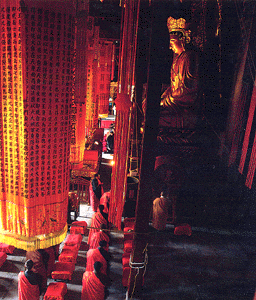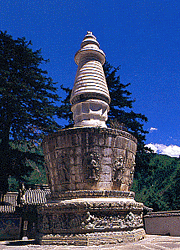
![]()
|
Death and Rebirth By Ven. Bhikkhu Vinita In the western world where priorities are youthfulness, wealth, power and generally having a "good time", the word death tends to be unwelcome, even unholy. Minds are shut from the notion of being able to die at almost any time. Or at least, people believe death will not happen to them for a long time to come. Even when death occurs, the deceased is often beautified with cosmetics -- nearly all-funeral parlors have beauticians or morticians these days. Truth is, death occurs every moment of our lives. Cells in our bodies live and die and are replaced by newly generated cells. We get reborn every moment. This life continuum, or existence, is like the river that flows seemingly constant, seemingly an entity. But not single drop remains the next day of the watery column that had formed the river the day before. From a Buddhist viewpoint, when that life continuum -- that existence -- is interrupted, the present manifestation of the stream of kamma-energy is transformed. This event is what we know as death. According to the Buddha, death is the temporary end of a temporary phenomenon. Death is not the complete annihilation of an existence because while organic life has ceased, the kammic force that had previously actuated is has not ended. Physical form is but the outward manifestation of the invisible force of kamma -- volitional actions. Form ceases in compliance with nature. With this death, the presumed identity of the once living being also ends. But the volitional impulses wrought by thought, word and deed will manifest in a way that we have come to call rebirth. This continuity flows unbroken, with no intermediate stage between one life and the next -- contrary to Tibetan Buddhist traditions that expounds a bardo stage. Rebirth immediately takes place within the 31 planes of existence. The unrelenting immediacy of rebirth may be compared to the lighting of a new candle with another candle. Fire from the first candle immediately causes the new wick to burn. There is no waiting upon positive contact. And the new flame cannot be said to have been a part of the first lighted candle.
Modes of Death The Buddha lists four ways that death occurs:
The first three are known as timely deaths (kalamarana). The last one is an untimely one (akalamarana). To describe how the fourfold occurrence of death, the Buddha described the four ways a candle flame may go out. A lighted candle may be extinguished when the wax is finished; when the wick is finished; when both wax and wick finish; and when some external cause like a gust of wind blows the candle out. The actions-results that bring about the fourfold occurrence of death is known in Buddhism as kamma classified according to function:
As death approaches, a thought, word, or deed done during one's life may present itself to the mind's eye. It may be a good (attaining meditative success, offering food to monks, and helping the needy) or bad (other criminal or immoral acts) and it appears very vividly in the mind. The general Buddhist view is that good kamma such as the development of jhana (meditative absorption) or bad kamma such as commission of the five heinous crimes (matricide, patricide, killing an Arahant, wounding the Buddha, splitting the Hold Order) will take effect regardless of other kamma upon death. Without such weighty kamma however, one may take as the dying thought an act done or memory recalled. These acts and memories recurs at the death-moment in the form of nimitta (signs). Sometimes these acts and memories produce nimitta of symbols, a mental image of any sight, sound, smell, taste, touch, or idea which predominated the kamma when it had been done. For a butcher, it could be images of knives, of the sound of animals screaming; for a physician, it could be visions of patients or even the small of disinfectant. These are known as kamma nimitta and they may present themselves in any of the sic sense-doors. Another sign, gati nimitta, is some symbol of a future birth. These symbols may be hellish fires, forests, mountains, a mother's womb, celestial mansion, etc. When these indications of future births occur and if the symbols show undesirable rebirth, they can sometimes is changed. This can be done by influencing the dying person to think good thoughts and counteract the influences of his gati nimitta. Gati nimitta, being always visual sighting, is presented to the mind-door as a dream. With the end of the death-consciousness in a being, the being dies. Then no material qualities borne of the mind and nutrients are produced, although a series of material qualities borne of heat goes on till the corpse is reduced to dust. Immediately after death, there arises a re-linking consciousness to a fresh existence. The life-continuum resumes and this stream of consciousness turn round again without ever slowing down.
|

